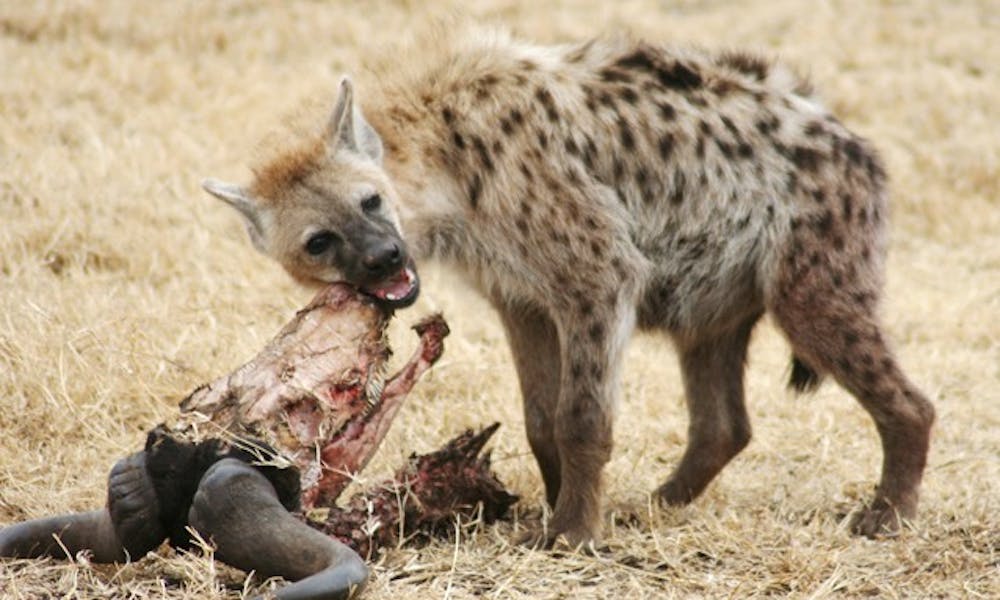Newly published research suggests that spotted hyenas cooperate and solve problems better than primates.
Christine Drea, professor of evolutionary anthropology, began her research more than a decade ago at the Field Station for the Study of Behavior, Ecology and Reproduction at the University of California at Berkeley. Her findings were recently published online in the this month’s issue of Animal Behavior. The research presents “the first experimental evidence of cooperation in a social carnivore,” according to the paper.
“[The research] shows that animals that evolved to be very efficient social hunters in nature… can transfer the general skill of cooperation to a task in captivity that doesn’t directly involve hunting but that taps into the underlying skill and tendencies to cooperate,” said Stephen Glickman, head of the Berkeley hyena project.
The paper, titled “Cooperative problem solving in a social carnivore,” describes three experiments that explore the behavior of eight captive hyenas paired in 13 different combinations. Unlike many primate species that do not possess a natural inclination for teamwork, the hunting behaviors of spotted hyenas demonstrate an innate aptitude for cooperation, according to the research findings.
“To me it was just amazing that non-primates could have such complex cooperative social behavior,” said Allisa Carter of the UC Berkeley, who co-authored the study.
It is only in the last several years that the science community has become more open to considering anything other than primates to study higher cognitive functions. Drea said the paper had previously been reviewed by Science and Nature, but was rejected for potential lack of “interest to the readership” rather than for experimental design.
“People started looking at different things in different species and finding that other species were doing things that were supposed to be specific to primates,” Drea said. “And they weren’t only doing them, but they were doing them better than primates.”
Spotted hyenas tailor the size of their hunting parties to match the type of prey they are going to chase, Drea said. Without being able to see or smell the prey, a group of spotted hyenas will form a zebra hunting party, for example, and consequently bypass any kind of other prey on their way because zebras require larger parties.
The apparatus Drea constructed was a modification of a design that had been done on chimpanzees in the 1930s. The study, by M.P. Crawford, was a rope pulling experiment in which the chimpanzees had access to food, but both chimps had to tug the rope along the ground in order to obtain their fare.
Drea chose to make the rope pulling task vertical because hyenas pull prey from above. She also created a double apparatus paradigm which sought to target whether the spotted hyenas could coordinate in space and time. A pair of hyenas was given a choice between two identical platforms 10 feet above the ground, each with a rope dangling from below. When both ropes were pulled in unison, a trap door was opened, releasing a food reward for the animals.
“I was much more interested in testing the cognitive abilities of a task that is a more naturalistic task,” Drea said. “Chimps don’t really need someone to help them pick a leaf…. Social carnivores are defined by their need to hunt in groups.”
Not only has Drea’s research shown that hyenas can cooperate with each other, but also that they are more flexible in their behavior than previously thought. Her experiments demonstrated that a dominant animal can change its role in a hunting setting.
“[The spotted hyenas] recognized when another animal was inexperienced in a hunting task and changed their behavior to increase the possibility of achieving the success,” Carter said. “If you put dominant animals [together] they can be less successful because their dominance influences their ability to cooperate.”
With these new findings introduced to the scientific community, future cognitive research could be conducted and applied to similar species such as canines and wolves, Drea said.
Get The Chronicle straight to your inbox
Signup for our weekly newsletter. Cancel at any time.

